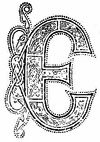Irish Historical and Romantic Tales
From A Smaller Social History of Ancient Ireland 1906
« previous page | contents | next page »

Sculpture on Window, Cathedral Church, Glendalough: Beranger 1779 (From Petrie’s Round Towers)
CHAPTER XI.
HISTORICAL AND ROMANTIC TALES
SECTION 1. Classes, Lists, and Numbers.

VEN from the most remote times, beyond the ken of history, the Irish people, like those of other countries, had stories, which, before the introduction of the art of writing, were transmitted orally, and modified, improved, and enlarged as time went on, by successive shanachies, or 'storytellers.' They began to be written down when writing became general: and a careful examination of their structure, and of the language in which they are written, has led to the conclusion that the main tales assumed their present forms in the seventh, eighth, and ninth centuries; while the originals from which they sprang are much older. Once they began to be written down, a great body of romantic and historical written literature rapidly accumulated, consisting chiefly of prose tales. Of many of the tales we have, in the Book of the Dun Cow, and the Book of Leinster, copies made in the eleventh and twelfth centuries; and there are numerous others in manuscripts copied by various scribes from that period to the present century, many of them from original volumes older than the Book of the Dun Cow.
In the Book of Leinster there is a very interesting List of the classes to which the ancient historical tales belong, with a number of individual tales named under each class as examples, numbering altogether 187. This List is as follows (with a few additions from other sources):—1. Battles: 2. Imrama, Navigations, or Voyages: 8. Tragedies: 4. Adventures: 5. Cattle-raids: 6. Hostings or Military Expeditions: 7. Courtships: 8. Elopements: 9. Caves or Hidings (i.e. adventures of persons hiding for some reason in caves or other remote places): 10. Destructions (of palaces, &c.): 11. Sieges or Encampments: 12. Feasts: 13. Slaughters: 14. Pursuits: 15. Visions: 16. Exiles or Banishments: 17. Lake Eruptions.
We have in our old books stories belonging to every one of these classes. The whole number now existing in MSS. is close on 600: of which about 150 have been published and translated. But outside these, great numbers have been lost: destroyed during the Danish and Anglo-Norman wars.
